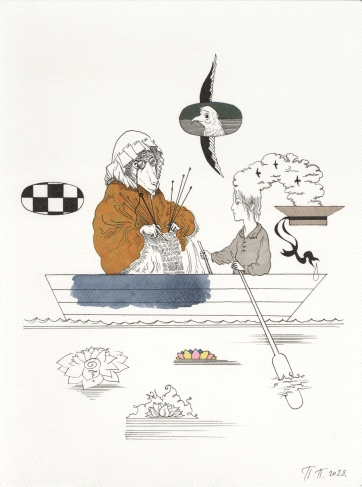Alice in Wonderland and Through the Looking Glass
Moscow, 17.09—15.12.2024
exhibition is over
Share with friends
For the press
Pavel Pepperstein
Alice in Wonderland and Through the Looking-Glass
Curator: Olga Sviblova
On 17 September Pavel Pepperstein’s exhibition ‘Alice in Wonderland and Through the Looking-Glass’ opens at the Multimedia Art Museum, Moscow.
Pavel Pepperstein is one of the most prominent and celebrated Russian artists. He is also a writer, poet and theorist of contemporary art. As the son of classic of Russian art Viktor Pivovarov and children’s writer and book illustrator Irina Pivovarova, he continues the traditions of Moscow romantic conceptualism in his work. Today the founder of the art group Inspection Medical Hermeneutics works in the PPSS group, together with Sonya Stereostyrski. Since the 1990s he has developed the principles of the ‘psychedelic realism’ movement he invented. In 2009 he was a participant in the Russian pavilion at the 53rd Venice Biennale.
In 2020 the V–A–C Press children’s publishing programme published Lewis Carroll’s ‘Alice’s Adventures in Wonderland’ with illustrations by Pavel Pepperstein, and in 2024, ‘Alice Through the Looking-Glass’. They feature among the artist’s most important and favourite books, which he has reread countless times. This famous tale of fantasy for children and adults, first published in 1865 in Victorian England and reprinted in numerous editions in all world languages, is certainly close to Pavel Pepperstein’s artistic universe. By setting himself the task of illustrating the fantastic tales of Alice, he has continued and developed the traditions of Soviet children’s illustration practised since the 1960s by future classics of Russian and world contemporary art, and once representatives of the Soviet underground, artists such as Ilya Kabakov, Viktor Pivovarov, Eric Bulatov, Oleg Vasiliev and others.
The development of Moscow romantic conceptualism is directly related to the experience of its founders in the field of children’s book illustration. This professional activity helped the conceptual artists find a visual language that proved useful in creating their own artistic worlds, where imaginary and playful reality find maximum expression. It is well known that the mechanisms of creativity and children’s play are deeply connected at psychological, social, and even neural levels.
The MAMM exhibition presents drawings for the two books by Lewis Carroll, as well as pictures related in some way to the Alice narrative. If you compare the drawings on display with the book illustrations, you may notice that many have acquired colour for the exhibition.
Lewis Carroll’s fairy tales comprise a world of dreams and illusions, detailed in the traditions of the Victorian era and filled with abstract mathematical and philosophical paradoxes, since their author was a mathematician, the creator of games, puzzles and logical paradoxes. One such paradox in ‘Wonderland’ and ‘Through the Looking-Glass’ is the game of scale, where everything may infinitely decrease or increase, changing the optics of our perception, bringing the object of our observation closer, or taking it infinitely further away from us. When devising paintings based on his own drawings for ‘Alice’, Pavel Pepperstein also worked with different scales. For comparison, in the sculptures of Jeff Koons, too, we often encounter a similar technique: a small children’s toy, created in an enlarged format and in a different material, is perceived in a fundamentally different way.
In Pepperstein’s paintings not only the format changes, and therefore our position of observation, but also details that are essential to his artistic world. In pictures from the cycle dedicated ‘to Alice’, elements of Suprematist constructions appear. Suprematism, the greatest achievement of the Russian avant-garde, was largely built on the basis of mathematical principles similarly embedded in Carroll’s fairy tales. But if at the beginning of the 20th century suprematism was a movement that set the vector of movement into the future, today, when art is faced with the search for new utopian concepts, the legacy of suprematism is perceived, according to Pepperstein, as “space debris rotating in near-Earth orbit”. The elements of suprematism or supremes are imperishable: although they have entered the space of art history, they still provide a breeding ground from which new utopias may sprout.
In the project for MAMM, which combines drawings, paintings and a wall fresco, Pepperstein offers adults and children new artistic paradoxes. The exhibition halls will feature Carroll’s fairy tales, narrated by the smart voice assistant ‘Alice’.
As part of the exhibition ‘Alice in Wonderland and Through the Looking Glass’, meetings with the artist will be organised, along with master classes for children and adults. A schedule of events in the parallel programme will be published on the mamm.art website.
Strategic partner: Alfa-Bank






